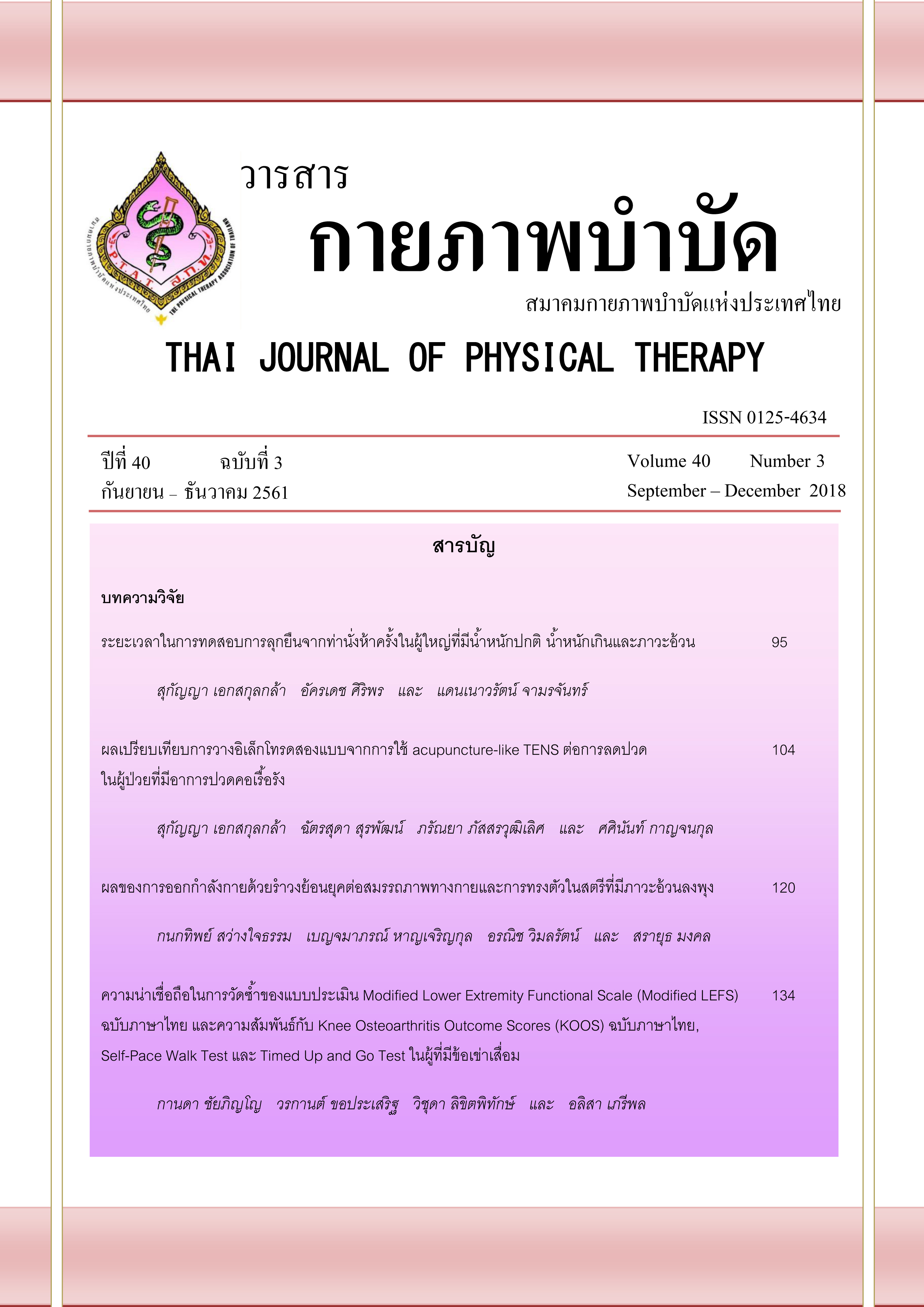Five-times-sit-to-stand test time in adults with normal weight, overweight and obesity
Main Article Content
Abstract
Background: Body mass index (BMI) is the ratio of height to weight. The World Health Organization used BMI as a screening criterion for overweight and obesity. A five-times-sit-to-stand test (FTSTS) is one of the most widely used tests for assessment of balance ability and lower limb muscle strength. It has been reported that an increased BMI affected the ability to control static balance, weight transfer tasks, and lower extremity muscle strength. However, there is a limited evidence of FTSTS performance in adults with difference of BMI.
Objective: To compare the time to perform the FTSTS test in adults with normal weight, overweight, and obesity.
Methods: Fifty four male and female volunteers with aged between 18-40 years were divided into 3 groups using BMI including: 1) normal weight group (BMI 18.5-24.9 kg/m2; n = 18), 2) overweight group (BMI 25.0-29.9 kg/m2; n = 18) and 3) obesity group (BMI ³ 30 kg/m2; n = 18). They were requested to perform five sit-to-stand repetitions as rapidly as possible and time of FTSTS were recorded.
Results: The obesity group showed a significantly longer time to perform FTSTS test (11.00±0.38 seconds) as compared with the overweight (9.97±0.32 seconds) and the normal weight groups (9.80±0.32 seconds) (p < 0.05). Whereas, no significant difference in FTSTS performance between the overweight and the normal weight groups was seen (p > 0.05).
Conclusion: Adults with normal weight and overweight performed the same ability on FTSTS and both groups performed better than the adults with obesity.
Article Details
References
Dall PM, Kerr A. Frequency of the sit to stand task: An observational study of free-living adults. Appl Ergon. 2010; 41(1): 58–61.
Schenkman M, BergerRA, Rlley PO, Mann RW, Hodge WA. Whole-body movements during rising to standing from sitting. Phys Ther. 1990; 70(10): 638-51.
Frykberg GE, Häger CK. Movement analysis of sit-to-stand – research informing clinical practice. Phys Ther Rev. 2015; 20(3): 156-67.
Lord SR, Murray SM, Chapman K, Munro B, Tiedemann A. Sit-to-stand performance depends on sensation, speed, balance, and psychological status in addition to strength in older people. J Am Geriatr Soc. 2002; 57(8): M539–43.
Wallmann HW, Evans NS, Day C, Neelly KR. Interrater reliability of the five-times-sit-to-stand test. Home Health Care Manag Pract. 2013; 25(1): 13–7.
Meretta BM, Whitney SL, Marchetti GF, Sparto PJ, Muirhead RJ. The five times sit to stand test: responsiveness to change and concurrent validity in adults undergoing vestibular rehabilitation. J Vestib Res. 2006;16(4-5): 233-43.
Thapa PB, Gideon P, Fought RL, Kormicki M, Ray WA. Comparison of clinical and biomechanical measures of balance and mobility in elderly nursing home residents. J Am Geriatr Soc. 1994; 42(5): 493-500.
Annweiler C, Schott AM, Abellan van Kan G, et al. The Five-Times-Sit-to-Stand test, a marker of global cognitive functioning among community-dwelling older women. J Nutr Health Aging. 2011; 15(4): 271-6.
Goldberg A, Chavis M, Watkins J, Wilson T. The five-times-sit-to-stand test: validity, reliability and detectable change in older females. Aging Clin Exp Res. 2012; 24(4): 339–44.
Ng SSM, Cheung SY, Lai LSW, Liu ASL, Leong SHI, Fong SSM. Five times sit-to-stand test completion times among older women: Influence of seat height and arm position. J Rehabil Med. 2015; 47(3): 262–6.
Zhang F, Ferrucci L, Culham E, Metter EJ, Guralnik J, Deshpande N. Performance on five times sit-to-stand task as a predictor of subsequent falls and disability in older persons. J Aging Health. 2013; 25(3): 478–92.
Kwong PWH, Ng SSM, Chung RCK, Ng GYF. Foot placement and arm position affect the five times sit-to-stand test time of individuals with chronic stroke. Biomed Res Int. 2014; 2014:636530.
Mong Y, Teo TW, Ng SS. 5-repetition sit-to-stand test in subjects with chronic stroke: reliability and validity. Arch Phys Med Rehabil. 2010; 91(3): 407–13.
Deforche BI, Hills AP, Worringham CJ, et al. Balance and postural skills in normal-weight and overweight prepubertal boys. Int J Pediatr Obes. 2009; 4(3): 175–82.
Pataky Z, Armand S, Müller-Pinget S, Golay A, Allet L. Effects of obesity on functional capacity. Obes Silver Spring Md. 2014; 22(1): 56–62.
Del Porto H, Pechak CM, Smith DR, Reed-Jones RJ. Biomechanical effects of obesity on balance. Int J Exerc Sci. 2012; 5(4): 301-20.
Gilleard WW, Smith TT. Effect of obesity on posture and hip joint moments during a standing task, and trunk forward flexion motion. Int J Obesity. 2007; 31(2): 267-71.
World Health Organization (WHO). Obesity: Preventing and managing the global epidemic, Report of a WHO consultation, Technical report series No.894. Geneva, 2000.
Khemlani MM, Carr JH, Crosbie WJ. Muscle synergies and joint linkages in sit-to-stand under two initial foot positions. Clin Biomech Bristol Avon. 1999; 14(4): 236–46.
Siriphorn A, Chamonchant D, Boonyong S. The effects of vision on sit-to-stand movement. J Phys Ther Sci. 2015; 27(1): 83–6.
Koo TK., Li MY. A Guideline of selecting and reporting intraclass correlation coefficients for reliability research. J Chiropr Med. 2016; 15(2): 155–63.
Sullivan GM, Feinn R. Using effect size-or why the p value is not enough. J Grad Med Educ. 2012; 4(3): 279–82.
Hergenroeder AL, Brach JS, Otto AD, Sparto PJ, Jakicic JM. The influence of body mass index on self-report and performance-based measures of physical function in adult women. Cardiopulm Phys Ther J. 2011; 22(3): 11-20.
Whitney SL, Wrisley DM, Marchetti GF, Gee MA, Redfern MS, Furman JM. Clinical measurement of sit-to-stand performance in people with balance disorders: validity of data for the five-times-sit-to-stand test. Phys Ther. 2005; 85(10): 1034–45.
Galli M, Crivellini M, Sibella F, Montesano A, Bertocco P, Parisio C. Sit-to-stand movement analysis in obese subjects. Int J Obes Relat Metab Disord. 2000; 24(11): 1488-92.

